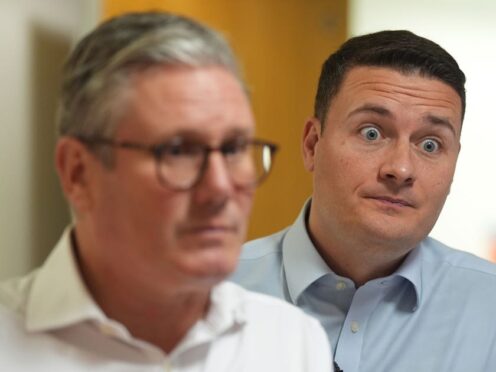
Shadow health secretary Wes Streeting admitted he is “never going to live this down” after failing to name Sir Keir Starmer’s six pledges for a Labour government.
The shadow cabinet minister correctly identified five of the six “first steps” Sir Keir has set out for Labour in power.
But he was forced to refer to his pledge card to name the sixth promise on tackling anti-social behaviour.
Challenged to name the six steps on BBC’s Sunday with Laura Kuenssberg, he said: “Economic stability, cut NHS waiting lists, 6,500 extra teachers, secure border command, Great British Energy, and … what’s the one I’ve missed?
“I’ve done them out of order.”
He pulled a pledge card out of his pocket and said: “The annoying thing is I was preparing for that question and I still fluffed it. I might as well just go home now.”
The Tories were quick to seize on his difficulty.
Conservative Party chairman Richard Holden said: “Sir Keir Starmer’s ‘pledges’ change so frequently even his own team don’t bother to remember what they are.
“Like the British public, Starmer’s Labour frontbench colleagues know he has no plan for Britain and would take us back to square one.”
Mr Streeting used his appearances on Sunday political shows to set out Labour’s plans to deliver an extra 40,000 NHS appointments a week.
Under the plans, hospitals will run evening and weekend surgeries, with staff and resources pooled across a region.
Patients will be offered appointments at nearby hospitals, rather than necessarily at their local one, allowing them to be treated faster.
“The annoying thing is I was preparing for that question and I still fluffed it”
Shadow Health Secretary Wes Streeting says he “might as well go home” after forgetting one of his party’s pledges as #BBCLauraK quizzes him and Defence Sec Grant Shappshttps://t.co/qMLbI7ISxc pic.twitter.com/0oRkYhbkZ9
— BBC Politics (@BBCPolitics) May 19, 2024
The party has pledged to spend £1.1 billion to pay staff extra for out-of-hours working to deliver the promised 40,000 weekly operations, scans or appointments.
Labour also announced a partnership with private provider Nuffield Health to treat NHS staff suffering joint pain to help get them back to work quicker.
Up to 4,000 extra places for NHS staff will be available in Nuffield Health’s joint pain programme free of charge, in partnership with the healthcare charity.
It is the latest sign of Mr Streeting’s willingness to use providers outside the NHS to provide services.
He told BBC’s Sunday with Laura Kuenssberg: “We want to use the spare capacity that exists in the private sector. They tell us they can do more and we want to work with them to put together a serious plan that gives them some stability and certainty over the medium term about what they can deliver, at what cost.
“I’m determined to make sure we get both the reassurance we need on patient safety but also value for taxpayers’ money.”
The opposition believes it can raise the £1.1 billion through clamping down on tax dodgers and tightening up the rules on non-domiciled people.
Labour highlighted the way staff at Guys and St Thomas’s in London used a high-intensity theatre (HIT) list to more efficiently perform more procedures.
The HIT list system involves increasing the number of anaesthetic, surgical and theatre staff in order to minimise the turnaround time between cases.

By using two theatres at the same time, surgeons can be operating at the same time as their next patient is being prepared and anaesthetised.
While on a normal working day they can perform three knee surgeries for patients, they get through 12 when doing a HIT list.
The HIT lists focus on one type of procedure at a time and take place at weekends.
Labour research indicated more than half of England’s hospitals close operating theatres at the weekends.
According to a Labour Party freedom of information request last year, hospitals performed an average of 795 procedures on weekdays, but just 176 on Saturdays or Sundays.
British Medical Association council chairman Professor Philip Banfield said: “Expecting staff to stretch themselves thinner and thinner will do nothing to keep doctors in the NHS or attract new recruits.
“As Labour well know, the waiting list began rising more than a decade ago, reaching a record high last year, so bringing it down in a meaningful way will take time.
“Pledges like this may make good headlines, but they have to be taken with a dose of reality. If they are up for taking the medicine, however, we may finally reverse the decline in this nation’s health.”

Enjoy the convenience of having The Sunday Post delivered as a digital ePaper straight to your smartphone, tablet or computer.
Subscribe for only £5.49 a month and enjoy all the benefits of the printed paper as a digital replica.
Subscribe